How to create a 6-figure, 5-day new product launch (step-by-step guide)
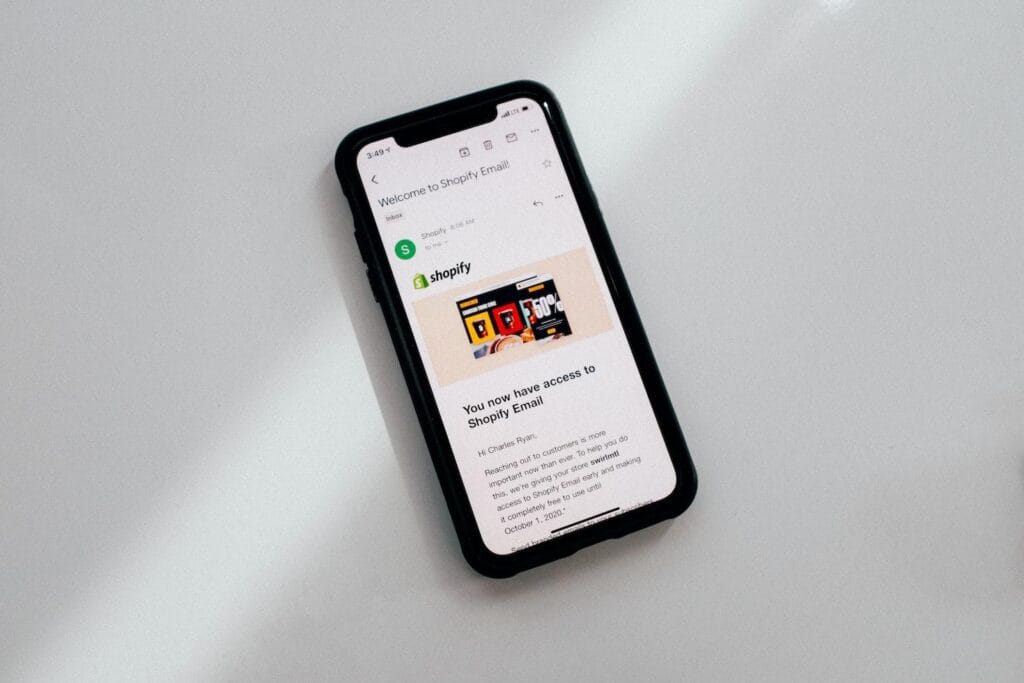
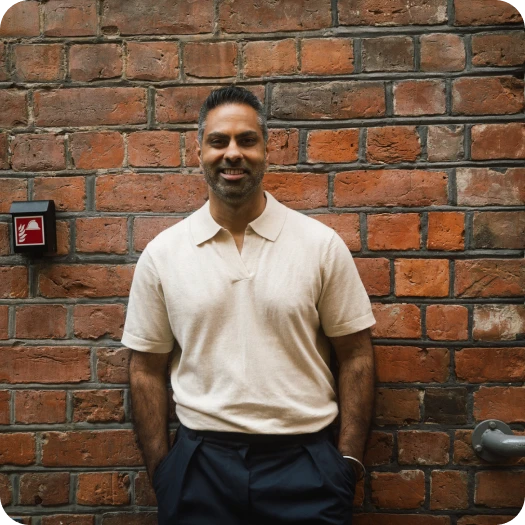
When we quietly launched a small new product called Mental Mastery at IWT, the product cost $299, and we made $617,944 on the initial launch. We did it without a webinar, without a discount, and without affiliates or any hard sell.
Even better, to our readers, it was just a few fun emails.
Today I want to take you behind the scenes of our Mental Mastery product launch and show you, step-by-step, how we did it.
This is the exact process we've used to create dozens of launches. Everything from:
- An ultra-casual series of emails that brought in $52,386 for our How to Talk to Anybody course (only mentioning the course twice)
- A fun 4-day funnel for our Call to Action copywriting course that netted $343,507
- And even the $5 million week for our flagship Zero to Launch course that Ramit Sethi analyzed here
For each, we followed the same 6-step process to ensure that the one- to three-week email marketing campaign at the heart of each launch — our "email funnel" — was engaging, effective, and profitable.
I call this 6 Layer Funnel Design.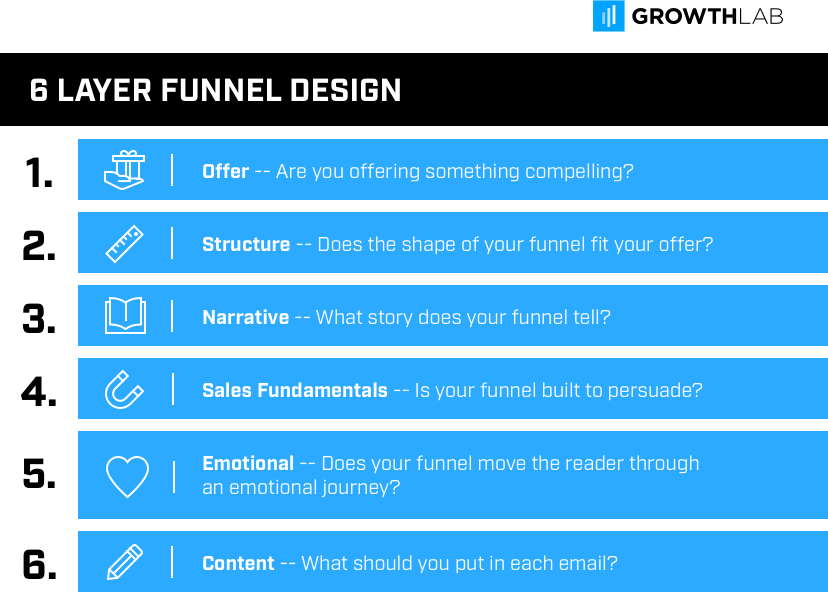
It's not enough to just write catchy emails. This is why so many business owners and copywriters send emails that look like they should be appealing...then wonder why they bomb.
If you want to build an email funnel that can drive a 6- or 7-figure launch, you need to dig under the surface. Every effective email funnel works on all six layers.
And the secret to creating funnels that work every time? Build your funnel one layer at a time.
To show you this process in action, let me walk you through how we used it to create our 5-day, $617,944 email funnel for our Mental Mastery course.
Table of contents:
STEP 1: Offer — Are you offering something compelling?
STEP 2: Structure — Does the shape of your funnel fit your offer?
STEP 3: Narrative — What story does your funnel tell?
STEP 4: Sales fundamentals — Is your funnel built to persuade?
STEP 5: Emotion — Does your funnel move the reader through an emotional journey?
STEP 6: Content — What should you put in each email?
Step 1: Do you have an irresistible offer?
Fact: An email funnel can only be as good as the offer it's built on.
This is one of the "secrets" of our success at IWT and GrowthLab, as well as the fundamental error that many marketers make. If you get the core offer right, everything else becomes much, much easier (and more profitable). And if you get it wrong, no amount of funnel design or sales wizardry can save you. You can't polish a turd.
When Ramit says "we’ve spent YEARS building things that we eventually scrapped because it wasn’t up to our standards," he's talking about our offers. This foundation-first approach is why we can attract students for life and consistently run 6- and 7-figure funnels without gimmicks or sleazy sales tactics.
Every good offer considers the 5 Ws:
- What: What product are you selling? At what price point?
- Who: Who are you selling to? What do they want, fear, hope, and need?
- Where: Where are you connecting with your audience?
- When: Are there any time constraints on your offer?
- Why: Why are you making this offer at all? What's in it for your audience?
Every funnel we create at IWT is built on extensive product and customer research.
For our Mental Mastery launch, all of this research was about making sure we're connecting the right audience (ambitious Top Performers interested in personal development) with the right need (cracking the code on what separates winners from everyone else) at the right price point ($299, a price high enough to scare away the "get rich quick" tire-kickers but low enough to make joining an easy decision for serious students).
If your funnels are chronically underperforming, start by double-checking your offer. Chances are you're:
- Speaking to the wrong audience
- Making an offer that doesn't address one of their burning desires or urgent pain points
- Selling it at the wrong price
Or all of the above.
You can read more about sharpening your offer, testing your business idea and doing product research here:
- GrowthLab’s Ultimate Guide to Starting an Online Business
- How to guarantee your idea will work
- Case Study: How I went from $0 to $22,000 by testing my business idea
Want to build a business that enables you to live YOUR Rich Life? Get my FREE guide on finding your first profitable idea.
Step 2: The boring but important structure of your funnel
Now that you have a compelling offer, it's time to give your funnel some shape.
There are 3 decisions you must make that will impact every piece of your funnel:
1. Can readers purchase your product at any time or is this a limited-time opportunity?
Open sales (purchase at any time) work great for low-price offers and membership programs. The scarcity of closed sales (limited time offers) creates momentum and urgency for new product launches and high-ticket items.
Funnels with open sales tend to be casual and more flexible. Closed funnels tend to be high-pressure and more structured.
Closed funnels will always result in more sales...until you burn out your audience and they stop listening. So use them carefully. (More on how to do this in Step 4.)
2. When does your funnel start and stop?
Next, pick the start and end dates for your funnel. These can align with your personal and business schedules, but it's always best to avoid holidays. (Nobody's itching for the next installment of your email funnel over Memorial Day weekend.)
Here is a handy rule-of-thumb for how long your email funnels should be:
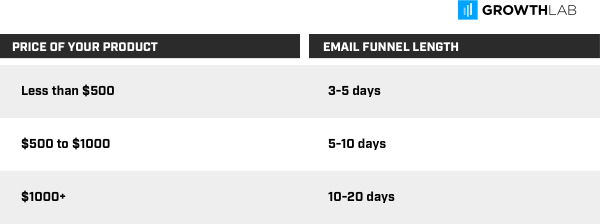
(In our experience, if you have a limited time opportunity, it's best to make sure your sales window is at least 3 days long and ends on a Thursday or Friday.)
3. Are there any big events to include in your funnel?
These could be a webinar or a book launch or a live event. Maybe an application process for a very exclusive offer. Something time and date dependent that you'll need to build your funnel around.
Events like these always complicate a funnel. It's best to avoid them unless they directly support your offer. And if your product is less than $500, don't bother. It's not worth the hassle.
For our Mental Mastery launch, we answered each of these questions before even thinking about what to write:
- Closed sales: Because this was a new product launch, we restricted the sales window to four days. We wanted to make this launch an exclusive treat just for the students who joined.
- 5 days: Because the course was only $299, we limited the funnel to 5 days. That meant we'd have to introduce the product on Day 2. And we scheduled the launch for an open week in August, away from any holidays.
- No big events: Because the price was so low and the funnel so short, we said "no" to any events. This funnel was going to be email-only.
If the structure of your funnel is off, it could reduce your launch revenue by 50% (or more) as well as waste weeks of hard work. Take the time to make sure the structure is sound.
You can read more about webinars, scarcity, and other funnel structure considerations here:
Step 3: What story are you telling?
The most effective email funnels — the ones that pull in 6 and 7 figures — are more than just a grab-bag of random emails. They have a BIG IDEA. And they tell a story.
Great funnels have an underlying narrative arc that runs through them and conveys a powerful message. And every email in that funnel fits that narrative and message.
First, ask yourself:
- "What is the core message that this funnel should express?"
- "What is the BIG IDEA in this funnel?"
We built our Mental Mastery funnel on this Big Idea:
The Winner's Secret: The best of the best play by different rules than everyone else. That's how they can be so much more productive, resilient, and successful than everyone else. We've decoded those secret rules and can show how you can play — and win — by them, too.
If you don't have something new and BIG and interesting to say, why would anyone read your emails — or buy your product? They won't! That's why getting crystal clear on the Big Idea behind your funnel is so important.
The best ideas offer something surprising, exciting, and counterintuitive:
- "What story am I telling?"
- "What thread should run through every piece of this funnel?"
There are four basic types of narratives that you can use to shape your funnel:
- Narrative: This is a story full of ups and downs, surprises, and breakthroughs. Your funnel can trace your quest to start your company or create your product. Or the life-changing transformation one of your customers went through.
- Demonstration: Show your product in action. Show personal results. Show customer results. Show real-time results. Infomercials use this approach all the time.
- Challenge: Push your readers to take action today. Pat Flynn of Smart Passive Income used this approach with his Build Your Own Brand 5-Day Challenge.
- Announcement: If you're making a compelling and exclusive offer just to your best customers, all you may need is a simple announcement about what's coming.
For our Mental Mastery funnel, we quickly mapped out both a Narrative and Demonstration approach to see how each of these narratives would fit into our funnel structure:
A Narrative approach:
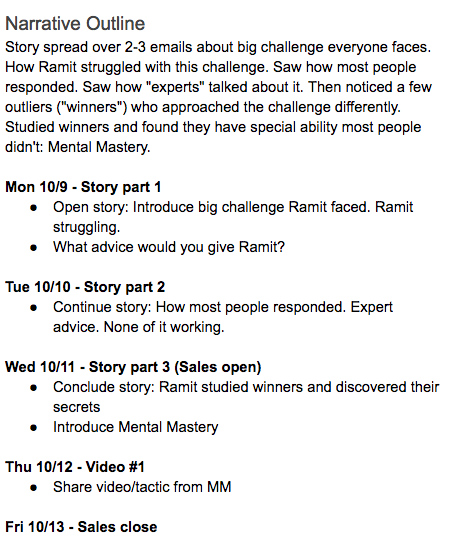
And a Demonstration approach:
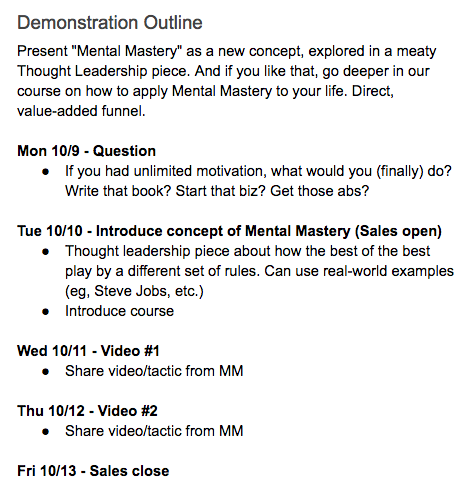
Notice how the email ideas at this stage are still vague placeholders. At this point, we're just looking at the narrative structure. Which approach will best express our Big Idea and core offer?
For this funnel, we chose a Demonstration approach because we felt that showing Mental Mastery in action would be the most compelling for our readers.
By building your email funnel one layer at a time, you can quickly street-test your options and go with the most compelling result.
For more on Big Ideas and standing out:
Learn to take control of your finances and spend your money GUILT-FREE with our free Ultimate Guide To Personal Finance below:
Step 4: How to make your funnel compelling
At this point, we have a compelling offer, and we know the structure of our funnel. We also found a Big Idea to grab everyone's attention and a narrative structure to hold everything together.
But will it sell?
The next step in 6 Layer Funnel Design adds the fundamentals of sales. Use the AIDA formula (Attention, Interest, Desire, Action) to make sure your funnel will move people from where they are today to actually purchasing your product:
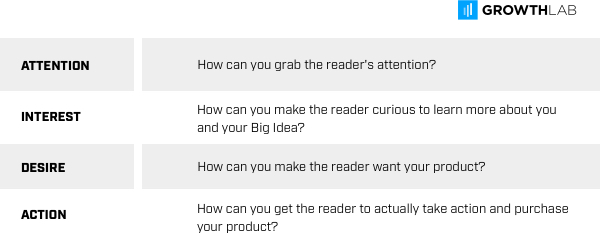
In a long funnel, like the $5,000,000 four-week funnel we built for Zero to Launch, each step in the AIDA formula could receive an entire week.
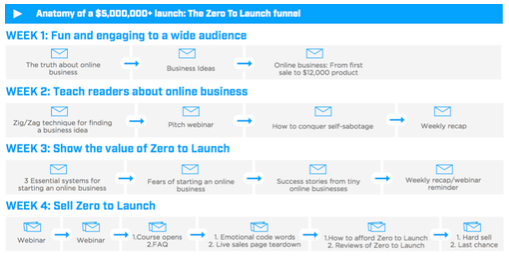
For a short funnel like our 5-day pitch for Mental Mastery, the steps are condensed but still there. To call them out, we mapped the AIDA formula against our in-process outline:
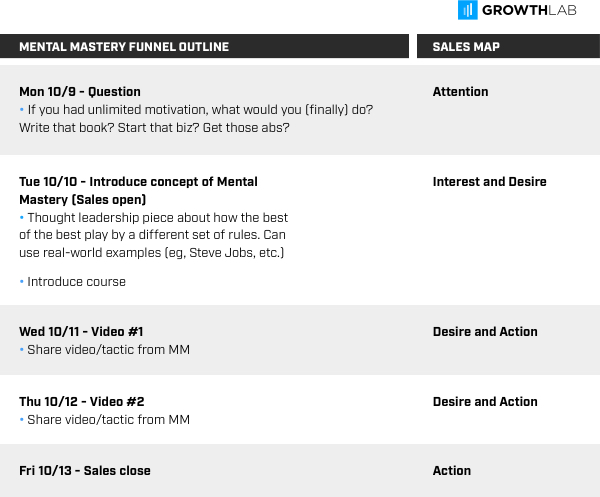
Mapping out our plan against the AIDA formula gave us some valuable insights:
- For this funnel to work, the Tuesday thought leadership piece would be a critical email. That piece would need to not just introduce the idea of Mental Mastery but really get people excited about it and eager to learn more about our course.
- The second email was going to be big, so the first email should probably be short and light.
- Also, we needed another way to grab people who missed or weren't fully hooked by our first two emails. That gave us the idea to include another "Attention" email on Wednesday morning.
We took another pass at the funnel outline with this information in hand:

As you can see, each layer in the process brings us a little bit closer.
For more on the AIDA formula, check out this article.
Step 5: The emotional journey
There is one more step in 6 Layer Funnel Design before we dig into the content of individual emails. That is mapping the emotional journey.
A funnel should move the reader emotionally — from where they are today to being excited enough to buy your product.
You can actually map out this emotional journey to make sure each of the emails in your funnel hits the right notes at the right time.
That's exactly what we did for our Mental Mastery funnel. Here's what it looked like:
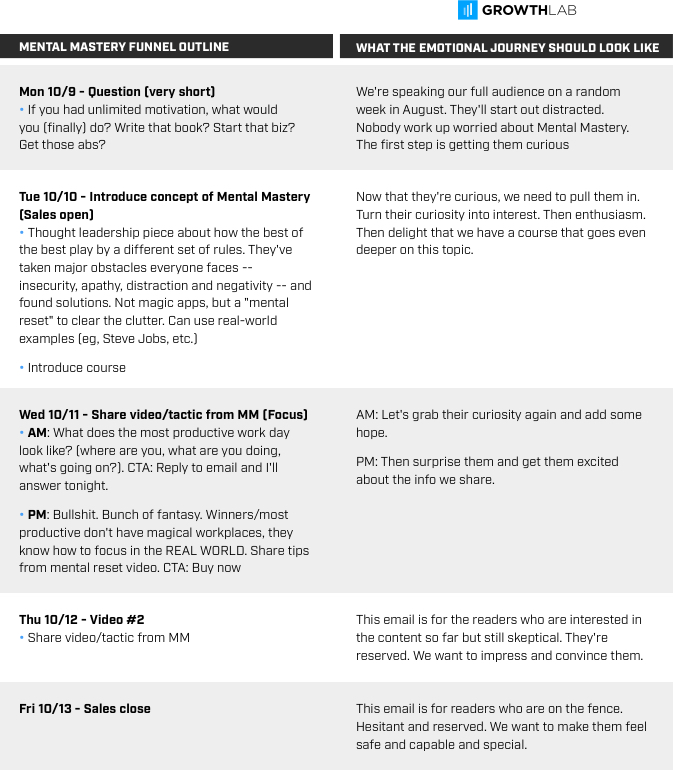
Mapping out the emotional journey in our 5-day funnel sheds more light on what was working and not working in our outline so far:
- The Monday and Tuesday emails sounded promising, but the Wednesday PM email was hitting the wrong note. We wanted to surprise and excite our readers. Calling them out here would just turn them off.
- The Thursday video needed to be very content-focused — not sales-focused — because we were trying to impress the reader. We needed to lean into that impressive feeling.
- Also, our sales close email on Friday should make people feel good (not stressed that they might miss something or that they're making a mistake by saying no).
These subtle but important details gave us a very clear picture of what each email should be. We were ready to start outlining!
For more articles about the emotional journeys and dead-ends that can impact your funnels, check out:
- What nobody tells you about a product launch: A diary
- What successful people don't tell you
- Confessions of a CEO: 8 types of people who will never buy your product
Step 6: Bring your funnel to life

When most people think about email funnels, this is the step that comes to mind — outlining and writing the actual emails that make up the funnel.
With 6 Layer Funnel Design, this step is faster and the results are more consistently successful because each email is more than a random cool idea. It's built to fit all of the layers beneath it.
To begin, take each slot in your email funnel and brainstorm a number of possible emails that would fit that slot. You probably have placeholders or initial ideas from earlier steps in the process but don't stop there. Give yourself time to think about what other emails might work in your funnel.
I use a simple checklist to make sure that any email we write has a very high probability of being successful:
- Does this email support the Big Idea and narrative structure of this funnel?
- Does this email fit into the sales framework for this funnel?
- Does this email align with the emotional map for this funnel?
- Does this email flow from and to the emails around it?
- Is this email valuable and fascinating on its own, independent of the funnel?
- If you received this email, would you be excited to read and share it?
If the answer to every one of these questions is "yes," then that email is worth keeping.
Here's what our first pass at the Mental Mastery funnel emails looked like:
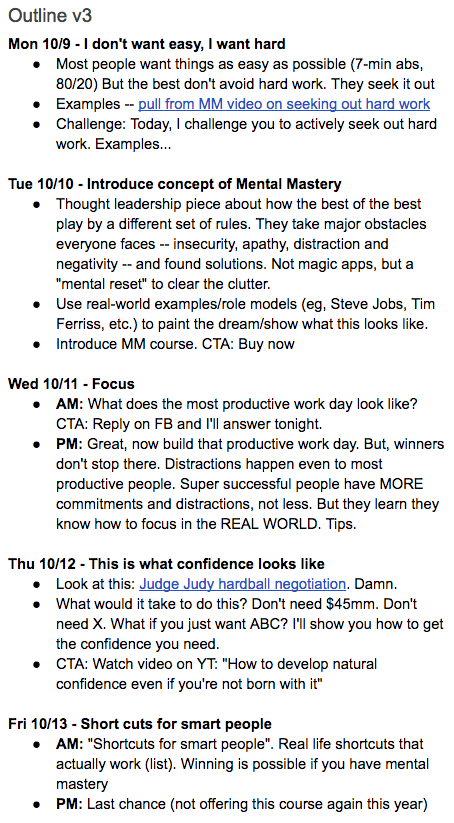
You'll notice that the shape and focus of the funnel didn't change. That's because we're not guessing what will work in this funnel. We're building on top of a very sturdy and compelling 5-layer foundation.
Some of the emails — like the Tuesday thought leadership piece and the Wednesday AM question email — we kept as-is because they hit all the points we wanted them to. We were itching to write, read, and share them. (Which is a really good sign you're onto something.)
Other emails became richer and more focused. We found a new Monday opening that delivered more value and better expressed our Big Idea while still grabbing the reader's attention.
And the support of the preceding 5 layers allowed us to find compelling angles and fresh content for the remaining emails, like our Thursday video and our punchy sales close on Friday.
Plus, 6 Layer Funnel Design makes it easy to keep expanding your outlines with more details, examples, and stories until they're simple to write. With each pass at the outline, just brainstorm your options and keep the ones that fit the six layers.
For more tips on how to find and write great emails, check out:
- How to find 20+ blog ideas your audience can't wait to read
- Get the 5-day email funnel that generated $400k from a single launch
- GrowthLab's Ultimate Guide to Email Copywriting: How to write emails that stand out
Summing up: Six Layer Funnel Design
As you can see, there is much more to an email funnel than some sticky subject lines and crunchy tactics. The best funnels work on multiple levels at once. And the secret is building your funnels using Six Layer Funnel Design.

Learn to take control of your finances and spend your money GUILT-FREE with our free Ultimate Guide To Personal Finance below:
It’s one of the best things I’ve published (and 100% free), just tell me where to send it: